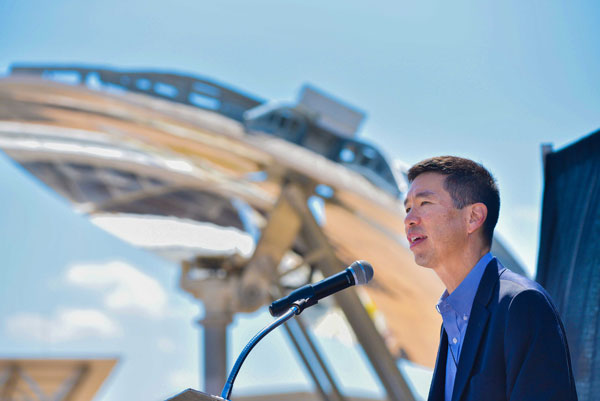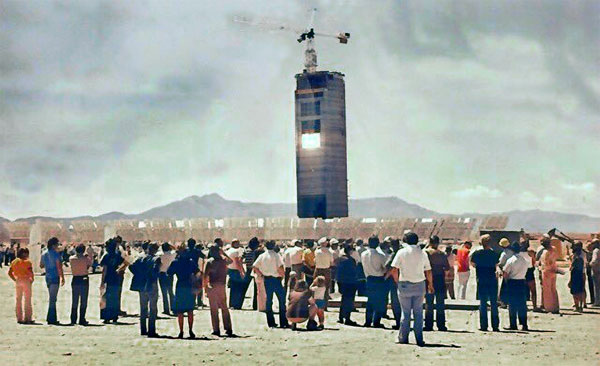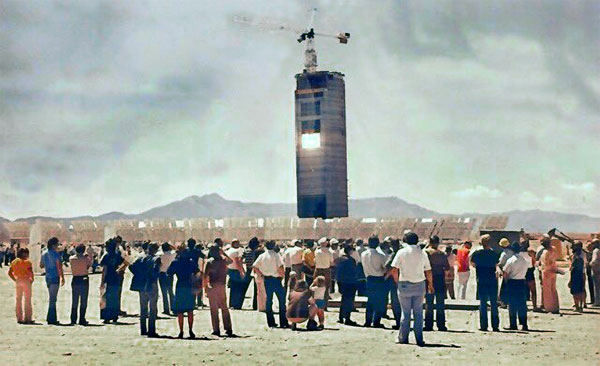Researchers, industry gather for celebration
From heating up space shuttle tiles to making electricity from sunlight, the world’s first multimegawatt solar tower has contributed to energy research, space exploration, defense testing and solar energy commercialization since it was commissioned at Sandia in July 1978.
To mark the National Solar Thermal Test Facility’s 40th anniversary in July, present and past Sandia staff and managers, industry leaders and government representatives came together for a day of talks and tours focused on the history of the facility, its contributions to solar energy and other fields and the current research outlook.

The solar tower is a key component of a specific type of utility-scale solar energy technology that uses hundreds of large mirrors to reflect and concentrate sunlight onto a receiver on a tower. The heat from the concentrated sunlight is absorbed by either a liquid, gas or solid and either stored or used immediately in a heat exchanger to generate electricity. This type of energy, called concentrating solar power, is appealing because it can supply renewable energy — even when the sun is not shining — without using batteries for storage.

“The 40th anniversary of the NSTTF was well received by all who attended, though it was particularly special for those who have worked there,” said engineer Ken Armijo, lead organizer for the celebration. “The event afforded folks the opportunity to meet the multiple generations of staff members that made the NSTTF successful. It was great to talk to those that came before, and discuss the exciting road ahead at the NSTTF with the impending DOE Gen3 work that will be starting this fall along multiple concentrating solar power technology pathways. It was inspiring to hear from the impressive lineup of speakers that gave podium talks, and to realize the tremendous potential we as NSTTF staff members have in making an impact in the U.S. and the world.”
Speakers at the event included Armijo and Paul Gauche, NSTTF manager; Dori Ellis, associate labs director; U.S. Rep. Ben Ray Lujan; representatives of U.S. Sens. Tom Udall and Martin Heinrich and Rep. Michelle Lujan Grisham; Kevin Smith, SolarReserve’s chief executive officer; and distinguished Sandia engineers Charles Andraka and Cliff Ho.
Rep. Lujan congratulated Sandia on the milestone and said that the facility is a perfect example of what’s possible when the U.S. pursues a clean energy economy. He also noted that it offers remarkable capabilities for energy researchers, whose efforts help the nation support the development of solar energy.
The origins of Sandia’s solar tower
Gauche said the DOE funded the creation of the solar tower and the National Solar Thermal Test Facility at Sandia during the height of the oil crisis in the late 1970s, when both concentrating solar power and photovoltaic solar energy were novel ideas.


“Concentrating solar power was a big deal during the later parts of the oil crisis,” Gauche said. “The funding for research through the early ‘80s was, put in terms of 2018 dollars, somewhere in the region of $100 million to $200 million a year nationwide,” Gauche said. “Funding levels have varied, but the U.S. has continued to consistently invest in concentrating solar power through the years.”
When it was built, the solar tower used a large steam receiver to absorb the heat from concentrated sunlight for research and to demonstrate the technologies needed for multimegawatt tower-based concentrating solar power. Previous research by other groups used parabolic trough designs and kilowatt-scale tower designs.
Gauche said that in 1981 the research at Sandia lead to a joint effort with Rocketdyne, a rocket manufacturer, to develop Solar One, which became the world’s first operating solar tower. An operating tower can deliver power to the electrical grid, but not on a commercial basis.
“There are three main steps that were achieved,” Gauche said. “Sandia had the research tower, which led to developing the first operating tower, and then there was commercialization as industry began to build and operate their own towers.”
Solar One was based in Barstow, California, used a steam receiver and had about 10 times more mirror-like heliostats than Sandia’s research tower, giving it 10 megawatts of electrical output. Gauche said Sandia and Rocketdyne in 1995 converted it to Solar Two, which used a molten salt receiver. Molten salts are heated to a high temperature and turn into a liquid. The hot salts flow through a receiver to absorb heat from sunligh and then can be stored in a tank until needed to generate electricity.
“This was the first demonstration of energy storage with concentrating solar power,” Gauche said. “It delivered storage-based solar electricity to the grid in Southern California.”
Solar Two was decommissioned in 1999

because, Gauche said, “it was a demonstration, and it had proved the point that concentrating solar power could work for utility-scale electricity generation.”
Supporting solar energy, space and security
Sandia’s solar tower at the National Solar Thermal Test Facility continued as a research hub for concentrating solar power as Solar One and Solar Two were operating, but its ability to generate high radiation flux from sunlight has been useful for other applications as well.
“Sandia has diversified the facility and used the tower to test space shuttle tiles and ablative materials used for landers going to Saturn,” Gauche said. “We’ve also done testing for the Air Force and other agencies for national security purposes.”
Concentrating solar power research has continued to advance as well. Currently, Sandia is leading one of three teams selected by the DOE’s Solar Energy Technologies Office to compete to build a high temperature concentrating solar power system with built-in heat storage.
Sandia’s proposed system uses sand-like ceramic particles to absorb and store the heat from the concentrated sunlight. Sandia already has developed the world’s first high-temperature falling particle receiver, and the research will refine and integrate that system into a complete pilot plant.
Sandia is also a partner on a team led by the National Renewable Energy Laboratory that is researching higher temperature molten salt capabilities.
Potentially, the National Solar Thermal Test Facility could host pilot testing over a five-year period.
